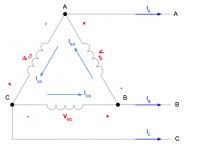Knowing when to use sqrt(3) in 3 phase can certainly be hard to remember, and some of my approach is based on minimizing when I have to use it to just a couple cases that I can remember. The most familiar place it pops up is that in a wye system, the L-L voltage is sqrt(3) times the L-N voltage.
In the sentence you quoted above, we already have the L-L voltage as 240V, and we're calculating the current through the coil, not through the legs. So once I divide the 50 kVA rating in 1/3 for the 3 coils, it's now a single phase, 2-wire problem. 50/3 kVA, 240V across the coil, divide to get the current in the coil, no sqrt(3).
In the next step I took two coil currents (say AB and CA) and added them up to get the leg current (on A). Those legs currents are out of phase, so that is a 3-phase type computation, and the sum of the two identical magnitude currents isn't twice the current, but sqrt(3) times the current. That's the other place I have to remember to use the sqrt(3).
The diagram below might help with visualizing things. In particular at that node labeled "A", you know that the sum of the currents (as vectors) has to be 0. And the fact that I
BA and I
AC aren't pointed in the same direction is the reason that their sum (when equal in magnitude) isn't twice their value.
Cheers, Wayne
View attachment 2564483



